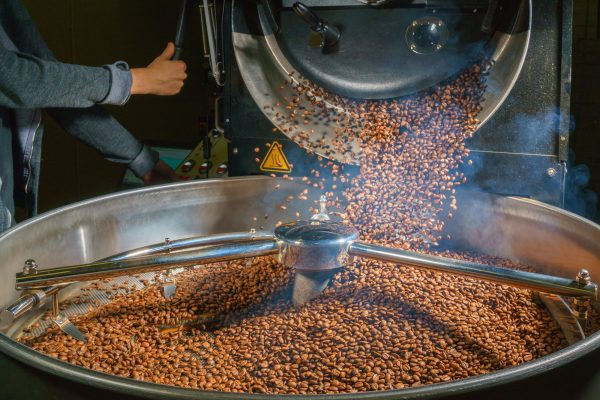
The style and philosophy of every coffee roaster is unique. But all have the same goal – to shepherd every batch of green coffee beans through a coffee roasting process that produces an exquisite cup of coffee.
There are multiple conditions that influence the flavor of a cup of coffee:
- Region where beans were sourced
- Water temperature used to brew the coffee grinds
- Coffee roasting equipment
- Coffee roaster’s skills
- Length of time roasting
- Temperature of roasting
- Size of the ground coffee
Below we will take a look at the skills, time and temperature components that affect flavor. The nuances of your coffee roasting technique are what make your roast unique. A few more seconds here and a few degrees hotter there make a big difference in the flavor. Read on to learn to roast coffee in a way that fits your unique style and philosophy.
Keep in mind that even the best roasters cannot make up for poor quality raw materials. As a roaster, you probably depend on a partnership with an importer to get your green coffee beans. Having a reliable source for high-quality green coffee beans is essential for successful roasting.
For the following suggestions, let’s assume you’re starting out with green beans that have all the potential in the world to deliver wonderful flavors under the care of your new coffee roasting techniques.
No matter what your level of experience in coffee roasting – maybe you’re a budding coffee shop entrepreneur who wants to learn to roast coffee or maybe you’re a seasoned roaster – continuous learning will always serve you well.
We often associate the word deeper with the word darker. When it comes to coffee, this is not necessarily the case. Let’s think of deeper flavors the way we think about deeper people – more complex and nuanced.
Roasting brings out the flavors of the green coffee bean. If you were to eat a raw bean, it would taste like a vegetable and have a starchy mouthfeel. The delicious flavors we associate with coffee must be extracted from the raw bean. This is done through roasting.
Coffee Roasting Process
What are the variables in your coffee roasting process that impact the flavor of the final product? As a roaster, you can control the flavors by manipulating the amount of heat and the amount of time you roast the beans. The simplest description of roasting is heating coffee beans so they dry out and convert starches to sugars.
Let’s walk through the coffee roasting process and discuss how the roaster influences the flavor at each stage. Different coffee experts break the roasting stages down in different ways, but the general steps are as follows:
Drying:
Getting the water out of the green coffee beans is the first step. The moisture content of the beans is between 8 and 12 percent when you load them into your roaster. The beans need to be dry before they can be roasted. This step takes about six minutes in a drum roaster. The temperature should be about 160 degrees at this point.
You want to avoid burning the beans with temperatures that are too high. There is a risk that you could roast the bean on the outside, but the inside is undercooked. If the inside is undercooked, the bean will not roast evenly during the remainder of the coffee roasting process. At this point the look and smell of the beans shouldn’t have changed that much.
Yellowing
This is when the beans start to swell. The chaff falls away and the first roasting reactions start. When the temperature rises above 160 degrees, it will begin to smell like bread in a toaster.
Browning
In cooking, the phenomenon of browning – whether it’s meat or bread – occurs due to the Maillard reaction. This is when sugars are reduced, amino acids react to create different aromas and brown color.
A significant part of the roasted coffee flavor comes from the Maillard reaction which takes place between 300 and 400 degrees Fahrenheit. It’s at this level of heat where several hundred flavors are created during this intense chemical reaction.
Caramelization occurs at about 370 degrees Fahrenheit and is all about the sugar molecules. At this point, the natural sugars begin to caramelize. The level of sweetness in the bean decreases from candy sweet to honey sweet, but the flavor complexity increases.
First Crack
This is exactly what it sounds like. Gases (carbon dioxide) and water vapor have built up inside the bean and the bean breaks open when the pressure gets too high. You want the temperature to rise (it is just above 400 degrees now), and any remaining water in the bean to evaporate.
The bean is a light brown color at this point. If you’re looking for a light roast, you would dump the beans out of the roaster for cooling.
Roast Development
This is an important moment of decision for roasters. The temperature of the coffee keeps rising but you don’t want it to get too high, too fast. The heat influences which flavors come through, and which flavors disappear.
A chemical reaction called pyrolysis takes place at about 430 degrees Fahrenheit. The beans discharge carbon dioxide losing about 13 percent of their weight. And become a much darker brown.
Second Crack
Not all roasters continue to the second crack which happens just short of 450 degrees Fahrenheit. The cracking sound is primarily due to pyrolysis expelling carbon dioxide.
Roasters who do continue the coffee roasting process to the second crack are looking for a darker roast. Sugars and acids are broken down leaving a woody flavor.
When roasting continues far into the second crack, the flavor becomes smokey – think Italian or French roasts.
The 411 on Light, Medium and Dark Roasts
There was a time when roasting coffee through a second crack was common. As coffee roasting techniques have evolved, roasters have sought to bring out the deeper and more complex flavors attributed to the bean’s origin.
Roasters shape their unique flavors by managing the timing and temperatures during roasting. If you’re looking to showcase the origin of the coffee – variety of cherry fruit, region where it grows and how it is harvested – a light roast will help you get there.
Light roasts have sweet and fruity to taste with a floral aroma. Lively and bright are words often used to describe light roasts. To achieve this flavor, you would roast the coffee quickly and to a lower temperature. Temperatures of the bean would peak somewhere between 350 and 400 degrees Fahrenheit.
Medium roasts experience more caramelization and are, well, caramel sweet in flavor. Even so, there is still enough acidity present that they are not yet bitter. Spice notes, such as clove and pepper will come through clearly. You can still highlight the original characteristics of the raw coffee bean. To get this roast you would roast for a longer time at higher temperatures between 410 and 430 degrees.
Dark roasts are known for their bitter chocolatey flavor. Beans that have reached this dark color will have an oily sheen on their surface. There will be less (if any) flavor of the original bean and more of a roasted, even burnt, flavor. To reach this dark profile, you would take the batch through the second crack, reaching temperatures of about 465 degrees Fahrenheit.
Great Roasting Requires Great Raw Materials
Simple, right? The coffee roasting process is simple on the surface, but very complex chemical reactions are occurring inside the bean, drawing out many distinct flavors and aromas. Coffee scientists have created a Sensory Lexicon link for coffee tasting which identifies 110 flavor, aroma and texture attributes in coffee. The bottom line is that no matter how great of a roaster you are, raw material matters. The best coffee roasting techniques will not make up for poor quality green coffee beans. Set yourself up for success with an ICT for high-quality coffee beans.
Common Questions
How can one determine the optimal roasting time for achieving specific flavor characteristics?
Determining the optimal roasting time for specific flavor characteristics requires a combination of knowledge, experience, and careful observation. Start by understanding how flavors develop during the roasting process: lighter roasts highlight the bean’s origin flavors, while darker roasts emphasize bold, bitter notes. Monitor key events like the first and second crack, and use sensory cues such as color changes and aromas. Experiment with small batches, varying roasting times and documenting results. Consider bean variables like origin and density, and use the 20-25% development time ratio as a guideline. With practice and consistent cupping sessions, you’ll develop the intuition to fine-tune roasting times and achieve your desired flavor profiles. Remember that even small adjustments of 10-15 seconds can significantly impact the final taste.
What are the key indicators to look for during each stage of the roasting process?
The key indicators to watch during coffee roasting include visual, auditory, and olfactory cues. In the drying stage, look for the beans to turn from green to yellow. During yellowing, observe the beans swelling and smell for a bread-like aroma. The browning stage is marked by the beans turning light brown and the start of the Maillard reaction, producing complex aromas. Listen for the “first crack” around 385-400°F, signaling the beginning of light roast development. Watch for color deepening to medium brown for medium roasts. If aiming for dark roasts, listen for the “second crack” around 435-450°F. Throughout the process, monitor the rate of color change, as well as changes in bean size and surface texture. The aroma will evolve from grassy to sweet and caramel-like, eventually becoming more pungent in darker roasts. Temperature and time are also crucial indicators to track throughout the roast.
How does the origin of the green coffee beans influence the roasting process and final flavor?
The origin of green coffee beans significantly impacts both the roasting process and the final flavor profile. Beans from different regions vary in density, moisture content, and cellular structure, which affect how they respond to heat during roasting. For example, high-altitude beans are often denser and may require longer roasting times or higher temperatures. The origin also influences the inherent flavor characteristics: African beans typically offer fruity and floral notes, while South American beans are known for their nutty and chocolate undertones. Roasters must adjust their techniques to highlight these origin-specific flavors. The processing method used at origin (washed, natural, or honey) further impacts the bean’s moisture content and flavor potential. Skilled roasters tailor their roast profiles to each origin, considering factors like charge temperature, rate of rise, and development time to bring out the best qualities of the beans while balancing the roast-induced flavors.
